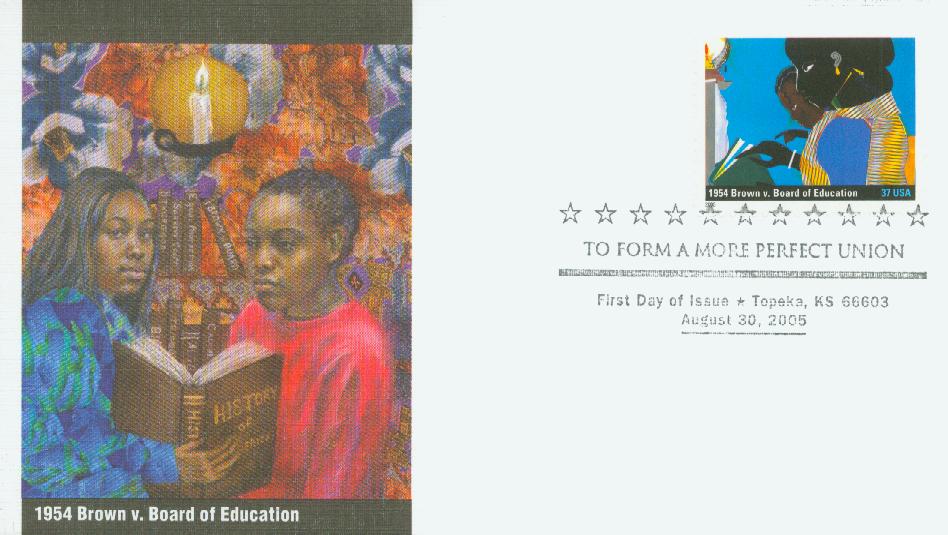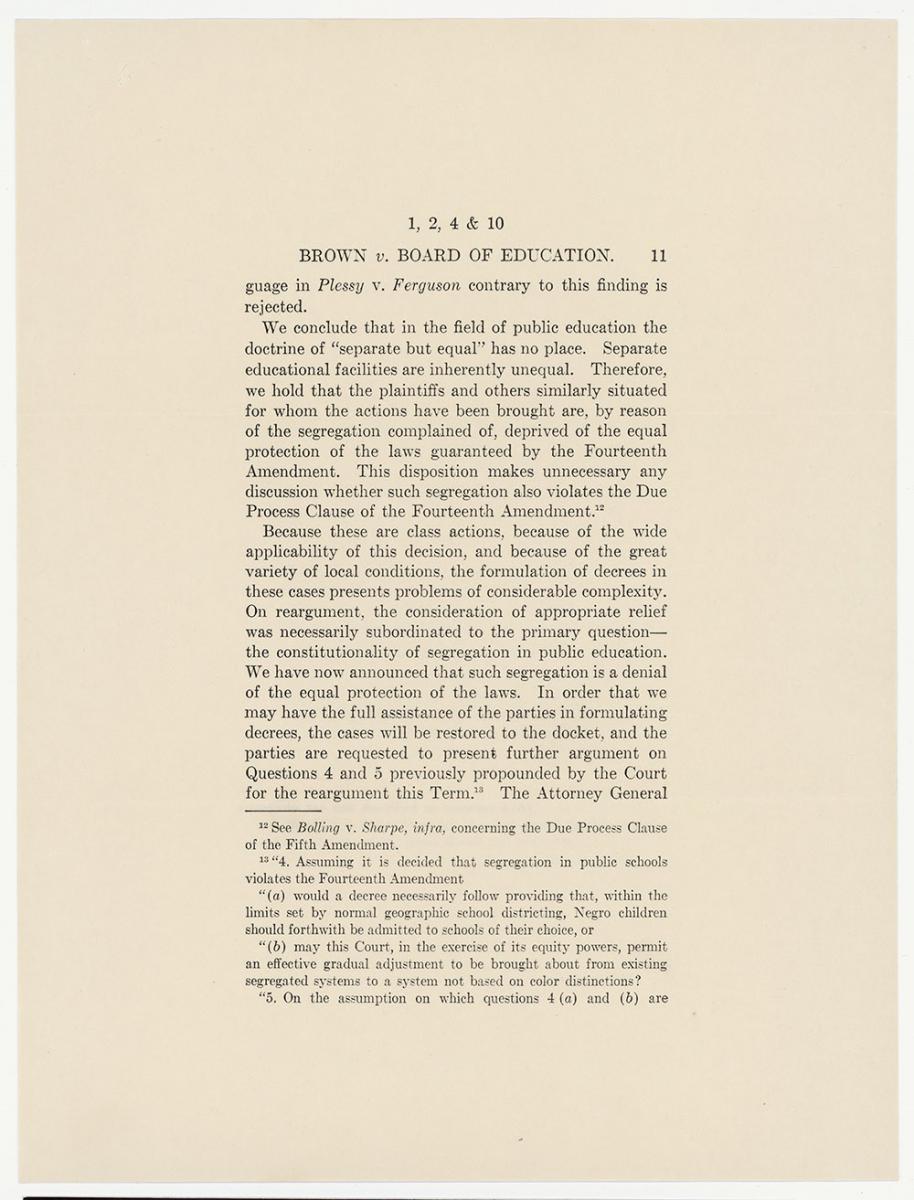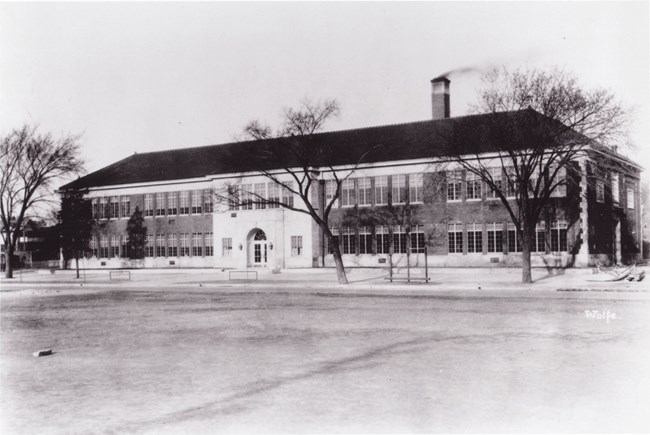Brown v. Board of Education of Topeka, 347 U.S. 483 (1954), was a landmark decision of the U.S. Supreme Court ruling that U.S. state laws establishing racial segregation in public schools are unconstitutional, even if the segregated schools are otherwise equal in quality. The decision partially overruled the Court’s 1896 decision Plessy v.Ferguson, which had held that racial segregation laws
Brown v. Board of Education of Topeka, Kansas – Brown v. Board at Fifty: “With an Even Hand” | Exhibitions – Library of Congress
Brown v. Board of Education of Topeka (1954) 347 U.S. 483 (1954) Justice Vote: 9-0. Majority: Warren (author), Black, Reed, Frankfurter, Douglas, Jackson, Burton, Clark, Minton. More in The Constitution. Share. “We conclude that in the field of public education the doctrine of ‘separate but equal’ has no place.

Source Image: learningforjustice.org
Download Image
Jan 4, 2024A Landmark Case Unresolved Fifty Years Later Spring 2004, Vol. 36, No. 1 By Jean Van Delinder “Today, education is perhaps the most important function of state and local governments.” —Chief Justice Earl Warren, Opinion on Segregated Laws Delivered May 1954 Enlarge First page of the landmark Supreme Court decision in Brown v. Board of Education of Topeka. (Records of the Supreme Court of the

Source Image: mysticstamp.com
Download Image
Brown v. Board of Education – Brown v. Board of Education National Historical Park (U.S. National Park Service) First page of the U.S. Supreme Court’s ruling in Brown v. Board of Education, May 17, 1954. Writing for the court, Chief Justice Earl Warren argued that the question of whether racially segregated public schools were inherently unequal, and thus beyond the scope of the separate but equal doctrine, could be answered only by considering “the

Source Image: cleveland.com
Download Image
Brown V. Board Of Education Of Topeka 1954 Decision
First page of the U.S. Supreme Court’s ruling in Brown v. Board of Education, May 17, 1954. Writing for the court, Chief Justice Earl Warren argued that the question of whether racially segregated public schools were inherently unequal, and thus beyond the scope of the separate but equal doctrine, could be answered only by considering “the The Supreme Court’s opinion in the Brown v. Board of Education case of 1954 legally ended decades of racial segregation in America’s public schools. Chief Justice Earl Warren delivered the unanimous ruling in the landmark civil rights case. State-sanctioned segregation of public schools was a violation of the 14th Amendment and was therefore unconstitutional. This historic decision marked the
Sixty years after Brown v. Board of Education, its promise of integrated, equitable schools is still elusive: editorial – cleveland.com
In Brown v. Board of Education of Topeka (1954) a unanimous Supreme Court declared that racial segregation in public schools is unconstitutional. The Court declared “separate” educational facilities “inherently unequal.”. The case electrified the nation, and remains a landmark in legal history and a milestone in civil rights history. Brown v. Board of Education of Topeka | National Archives

Source Image: archives.gov
Download Image
Brown v. Board of Education of Topeka (1) | Oyez In Brown v. Board of Education of Topeka (1954) a unanimous Supreme Court declared that racial segregation in public schools is unconstitutional. The Court declared “separate” educational facilities “inherently unequal.”. The case electrified the nation, and remains a landmark in legal history and a milestone in civil rights history.

Source Image: oyez.org
Download Image
Brown v. Board of Education of Topeka, Kansas – Brown v. Board at Fifty: “With an Even Hand” | Exhibitions – Library of Congress Brown v. Board of Education of Topeka, 347 U.S. 483 (1954), was a landmark decision of the U.S. Supreme Court ruling that U.S. state laws establishing racial segregation in public schools are unconstitutional, even if the segregated schools are otherwise equal in quality. The decision partially overruled the Court’s 1896 decision Plessy v.Ferguson, which had held that racial segregation laws

Source Image: loc.gov
Download Image
Brown v. Board of Education – Brown v. Board of Education National Historical Park (U.S. National Park Service) Jan 4, 2024A Landmark Case Unresolved Fifty Years Later Spring 2004, Vol. 36, No. 1 By Jean Van Delinder “Today, education is perhaps the most important function of state and local governments.” —Chief Justice Earl Warren, Opinion on Segregated Laws Delivered May 1954 Enlarge First page of the landmark Supreme Court decision in Brown v. Board of Education of Topeka. (Records of the Supreme Court of the

Source Image: nps.gov
Download Image
Brown vs. Board of Education Poster by Knoweldge Unlimited – The Black Art Depot Mar 18, 2024On May 17, 1954, U.S. Supreme Court Justice Earl Warren delivered the unanimous ruling in the landmark civil rights case Brown v. Board of Education of Topeka, Kansas. State-sanctioned segregation of public schools was a violation of the 14th amendment and was therefore unconstitutional. This historic decision marked the end of the “separate

Source Image: blackartdepot.com
Download Image
Planned Statehouse Mural To Honor Significance Of Brown V. Board Of Education Case | KMUW First page of the U.S. Supreme Court’s ruling in Brown v. Board of Education, May 17, 1954. Writing for the court, Chief Justice Earl Warren argued that the question of whether racially segregated public schools were inherently unequal, and thus beyond the scope of the separate but equal doctrine, could be answered only by considering “the

Source Image: kmuw.org
Download Image
Brown v. Board of Education – Summary & Impact | HISTORY The Supreme Court’s opinion in the Brown v. Board of Education case of 1954 legally ended decades of racial segregation in America’s public schools. Chief Justice Earl Warren delivered the unanimous ruling in the landmark civil rights case. State-sanctioned segregation of public schools was a violation of the 14th Amendment and was therefore unconstitutional. This historic decision marked the

Source Image: history.com
Download Image
Brown v. Board of Education of Topeka (1) | Oyez
Brown v. Board of Education – Summary & Impact | HISTORY Brown v. Board of Education of Topeka (1954) 347 U.S. 483 (1954) Justice Vote: 9-0. Majority: Warren (author), Black, Reed, Frankfurter, Douglas, Jackson, Burton, Clark, Minton. More in The Constitution. Share. “We conclude that in the field of public education the doctrine of ‘separate but equal’ has no place.
Brown v. Board of Education – Brown v. Board of Education National Historical Park (U.S. National Park Service) Planned Statehouse Mural To Honor Significance Of Brown V. Board Of Education Case | KMUW Mar 18, 2024On May 17, 1954, U.S. Supreme Court Justice Earl Warren delivered the unanimous ruling in the landmark civil rights case Brown v. Board of Education of Topeka, Kansas. State-sanctioned segregation of public schools was a violation of the 14th amendment and was therefore unconstitutional. This historic decision marked the end of the “separate